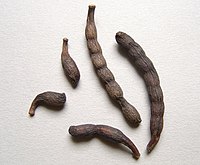| Xylopia aethiopica | |
|---|---|

| |
| Xylopia aethiopica plant | |
| Conservation status | |
 Least Concern (IUCN 3.1) | |
| Scientific classification | |
| Kingdom: | Plantae |
| Clade: | Tracheophytes |
| Clade: | Angiosperms |
| Clade: | Magnoliids |
| Order: | Magnoliales |
| Family: | Annonaceae |
| Genus: | Xylopia |
| Species: | X. aethiopica |
| Binomial name | |
| Xylopia aethiopica (Dunal) A. Rich. | |
Xylopia aethiopica is an evergreen, aromatic tree, of the Annonaceae family that can grow up to 20m high. It is a native to the lowland rainforest and moist fringe forests in the savanna zones of Africa.
The dried fruits of X. aethiopica (grains of Selim) are used as a spice and an herbal medicine.
Etymology
Xylopia is a compression from Greek ξυλον πικρον (xylon pikron) meaning "bitter wood". The second part of the plant's binomial name, aethiopica, refers to the origin of the tree, in Ethiopia, though currently it grows most prominently as a crop in Ghana, Togo and other parts of West Africa .
Distribution
Xylopia aethiopica grows in tropical Africa. It is present in rain forests, especially near the coast. It also grows in riverine and fringing forest, and as a pioneer species in arid savanna regions.
This species is present in the following countries:
|
|
|
Uses
Main article: Grains of Selim
Xylopia aethiopica is used extensively in construction, African cuisine and traditional medicine.
The plant's bark is used to make doors and partitions. The wood is known to be resistant to termite attack and is used in hut construction: posts, scantlings, roof-ridges and joists. The wood is also used for boat construction: masts, oars, paddles and spars. In Togo and Gabon, wood was traditionally used to make bows and crossbows for hunters and warriors.
An infusion of the plant's bark or fruit has been useful in the treatment of bronchitis and dysenteric conditions, or as a mouthwash to treat toothaches. It has also been used as a medicine for biliousness and febrile pains. The bark, when steeped in palm wine, is used to treat asthma, stomach-aches and rheumatism.
In Senegal, the fruit is used to flavor café Touba, a coffee drink that is the country's spiritual beverage and the traditional drink of the Mouride brotherhood. In the Middle Ages the fruit was exported to Europe as a 'pepper.' In the eastern part of Nigeria, the plant's fruit is an essential ingredient in preparation of local soups to aid new mothers in breastfeeding. It remains an important item of local trade throughout Africa as a spice, and flavouring for food and for medicine. The fruit is sometimes put into jars of water for purification purposes.
References
- Harvey-Brown, Y. (2019). "Xylopia aethiopica". IUCN Red List of Threatened Species. 2019: e.T137017018A149068646. doi:10.2305/IUCN.UK.2019-2.RLTS.T137017018A149068646.en. Retrieved 11 March 2023.
- "Xylopia aethiopica". Germplasm Resources Information Network. Agricultural Research Service, United States Department of Agriculture. Retrieved 2008-04-19.
- ^ Orwa; et al. (2009). "Xylopia aethiopica" (PDF). Agroforestry Database 4.0. World Agroforestry Center. Retrieved 1 January 2013.
- ^ "Xylopia aethiopica (Dunal) A.Rich". African Plant Database. Conservatoire et Jardin botaniques de la Ville de Genève. 16 April 2007. Retrieved 1 January 2013.
- ^ Harris, D.J.; Moutsamboté, J.-M.; Kami, E.; Florence, J.; Bridgewater, S. & Wortley, A.H. (2011). "An introduction to the trees from the North of the Republic Congo". Royal Botanic Garden Edinburgh. Retrieved 1 January 2013.
- ^ Burkill, Humphrey Morrison (1985). Entry for Xylopia aethiopica Dunal A. Rich.: family ANNONACEAE. JSTOR. Retrieved 1 January 2013.
{{cite book}}:|work=ignored (help) - Mitani, M. 1999. Does fruiting phenology vary with fruit syndrome? An investigation on animal-dispersed tree species in an evergreen forest in south-western Cameroon. Ecological Research, 14:371-383.
- ^ Missouri Botanical Garden. "Distributions:Xylopia aethiopica (Dunal) A. Rich". Tropicos.org. Retrieved 1 January 2013.
- ^ Robson, N. K. B. (1960). "Entry for Xylopia aethiopica Dunal A. Rich.: family ANNONACEAE". Flora Zambesiaca. JSTOR. Retrieved 1 January 2013.
- BBC Afrique (15 August 2012). "Café Touba, du bonheur plein la tasse" (Reprint) (in French). seneweb.com. Retrieved 1 January 2013.
- CRC Handbook of African Medicinal Plants, by Maurice M. Iwu, CRC-Press. ISBN 0-8493-4266-X
- Gernot Katzer's Spice Pages (accessed October 26, 2005)
External links
| Taxon identifiers | |
|---|---|
| Xylopia aethiopica |
|
| Unona aethiopica | |
This fruit tree-related article is a stub. You can help Misplaced Pages by expanding it. |
This Annonaceae article is a stub. You can help Misplaced Pages by expanding it. |